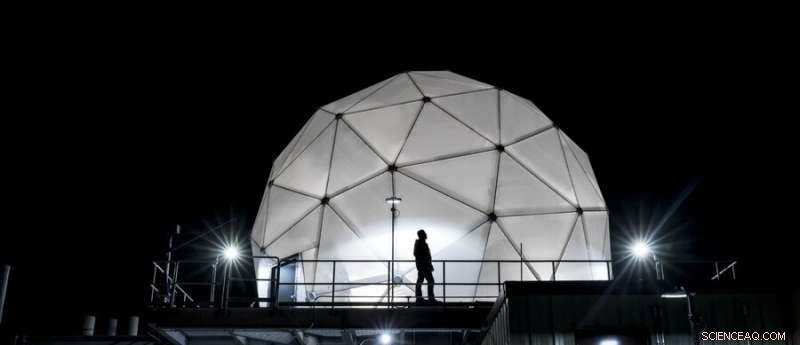
Wetenschap
Antenne maakt geavanceerde testen van satellietcommunicatie mogelijk

De koepel die de Multi-Band Test Terminal beschermt - een grote antenne op het dak van een MIT Lincoln Laboratory - wordt 's avonds verlicht weergegeven. Krediet:Glen Cooper, MIT
Op het dak van een MIT Lincoln Laboratory-gebouw bevindt zich een 38 voet brede koepelvormige radioantennebehuizing, of radome. In de klimaatgestuurde omgeving, afgeschermd van het weer in New England, ondersteunt een stalen structuur een satellietcommunicatieantenne van 20.000 pond, 20 voet diameter. De antenne, de Multi-Band Test Terminal (MBTT) genoemd, kan 15 graden per seconde draaien en voltooit een enkele omwenteling in 24 seconden. Met deze snelheid kan de MBTT satellieten detecteren en volgen in een gemiddelde en lage baan om de aarde (gemiddeld en laag verwijzen naar de hoogte waarop de satellieten om de aarde draaien).
Voorafgaand aan de installatie van de MBTT in 2017 vertrouwde het laboratorium op een verscheidenheid aan kleinere antennes voor SATCOM-tests, waaronder de Over-the-Air Ka-band Test Terminal of OTAKaTT. Vergeleken met de bijna twee meter lange OTAKaTT-antenne, is de MBTT zeven keer gevoeliger. En in tegenstelling tot zijn voorganger, is de MBTT, zoals de naam al doet vermoeden, ontworpen om gemakkelijk opnieuw te worden geconfigureerd om meerdere radiofrequentiebanden (RF) te ondersteunen die worden gebruikt voor militaire en commerciële satelliet-SATCOM-systemen.
"Als een veel groter, krachtiger en flexibeler testmiddel dan OTAKaTT, is de MBTT een gamechanger voor de ontwikkeling van geavanceerde SATCOM-technologie", zegt Brian Wolf, een technisch staflid bij Lincoln Laboratory's Advanced Satcom Systems and Operations. Groep.
Wolf was betrokken bij de installatie en de eerste inbedrijfstelling van de MBTT in 2017. Vervolgens leidde hij de MBTT door een rigoureus certificeringsproces met het U.S. Army Space and Missile Defense Command, voltooid in 2019, wat aantoonde dat de zend- en ontvangstprestaties van de antenne goed waren. voldoende om te kunnen werken op het Wideband Global SATCOM (WGS)-systeem. Een constellatie van 10 satellieten die eigendom zijn van en worden beheerd door het Amerikaanse ministerie van Defensie, WGS biedt verbindingen met hoge gegevenssnelheden tussen verschillende punten op aarde. Sinds 2019 is Wolf hoofdonderzoeker van een project dat eigenaar is van de MBTT, ter ondersteuning van de ontwikkeling van de Protected Anti-Jam Tactical SATCOM (PATS)-mogelijkheden van de U.S. Space Force.
"PATS ontwikkelt de mogelijkheid om beschermde tactische golfvorm- of PTW-diensten te leveren via WGS, evenals via commerciële transpondersatellieten en nieuwe DoD-satellieten met speciale onboard PTW-verwerking", zegt Wolf.
Zoals Wolf uitlegt, is een golfvorm het signaal dat tussen twee modems wordt verzonden wanneer ze communiceren, en PTW is een speciaal soort golfvorm die is ontworpen om zeer veilige, storingsbestendige communicatie te bieden. Jamming verwijst naar wanneer communicatiesignalen worden verstoord - hetzij per ongeluk door bevriende troepen (die bijvoorbeeld hun SATCOM-apparatuur verkeerd hebben geconfigureerd en op de verkeerde frequentie zenden) of opzettelijk door tegenstanders die communicatie proberen te voorkomen. Lincoln Laboratory begon in 2011 met de ontwikkeling van PTW en droeg bij aan het oorspronkelijke ontwerp en de systeemarchitectuur. In de jaren daarna heeft het laboratorium deelgenomen aan prototyping- en testinspanningen om de industrie te helpen volwassen modems te ontwikkelen voor het verwerken van de golfvorm.
"Our prototype PTW modems have been fielded to industry sites all over the country so vendors can test against them as they develop PTW systems that will be deployed in the real world," says Wolf. The initial operating capability for PTW services over WGS is anticipated for 2024.
Staff originally conceived the MBTT as a test asset for PTW. Directly underneath the MBTT is a PTW development lab, where researchers can run connections directly to the antenna to perform PTW testing.
One of the design goals for PTW is the flexibility to operate on a wide range of RF bands relevant to satellite communications. That means researchers need a way to test PTW on these bands. The MBTT was designed to support four commonly used bands for SATCOM that span frequencies from 7 GHz to 46 GHz:X, Ku, Ka, and Q. However, the MBTT can be adapted in the future to support other bands through the design of additional antenna feeds, the equipment connecting the antenna to the RF transmitter and receiver.
To switch between the different supported RF bands, the MBTT must be reconfigured with a new antenna feed, which emits signals onto and collects signals from the antenna dish, and RF processing components. When not in use, antenna feeds and other RF components are stored in the MBTT command center, located underneath the main platform of the antenna. The feeds come in a range of sizes, with the largest registering six feet in length and weighing nearly 200 pounds.
To swap out one feed for another, a crane inside the radome is used to lift up, unbolt, and remove the old feed; a second crane then lifts the new feed up into place. Not only does the feed on the front of the antenna need to be replaced, but all of the RF processing components on the back of the antenna—such as the high-power amplifier for boosting satellite signals and the downconverter for converting RF signals to a lower frequency more suitable for digital processing—also need to be replaced. A team of skilled technicians can complete this process in four to six hours. Before scientists can run any tests, the technicians must calibrate the new feed to ensure it is operating properly. Typically, they point the antenna onto a satellite known to broadcast at a specific frequency and collect receive measurements, and point the antenna straight up into free space to collect transmission measurements.
Since its installation, the MBTT has supported a wide range of tests and experiments involving PTW. During the Protected Tactical Service Field Demonstration, a PTW modem prototyping effort from 2015 to 2020, the laboratory conducted tests over several satellites, including the EchoStar 9 commercial satellite (which offers broadband SATCOM services, including satellite TV, across the country) and DoD-operated WGS satellites. In 2021, the laboratory used its PTW modem prototype as the terminal modem to conduct an over-the-air test of the Protected Tactical Enterprise Service—a ground-based PTW processing platform Boeing is developing under the PATS program—with the Inmarsat-5 satellite. The laboratory again used Inmarsat-5 to test a prototype enterprise management and control system for enabling resilient, uninterrupted SATCOM. In these tests, the PTW modem prototype, flying onboard a 737 aircraft, communicated through Inmarsat-5 back to the MBTT.
"Inmarsat-5 provides a military Ka-band transponded service suitable for PTW, as well as a commercial Ka-band service called Global Xpress," explains Wolf. "Through the flight tests, we were able to demonstrate resilient end-to-end network connections across multiple SATCOM paths, including PTW on military Ka-band and a commercial SATCOM service. This way, if one satellite communications link is not working well—maybe it's congested with too many users and bandwidth isn't sufficient, or someone is trying to interfere with it—you can switch to the backup secondary link."
In another 2021 demonstration, the laboratory employed the MBTT as a source of modeled interference to test PTW over O3b, a medium-Earth-orbit satellite constellation owned by the company SES. As Wolf explains, SES provided much of their own terminal antenna equipment, so, in this case, the MBTT was helpful as a test instrument to simulate various types of interference. These interferences ranged from misconfigured users transmitting at the wrong frequencies to simulation of advanced jamming strategies that may be deployed by other nation states.
The MBTT is also supporting international outreach efforts led by Space Systems Command, part of the U.S. Space Force, to extend the PATS capability to international partners. In 2020, the laboratory used the MBTT to demonstrate PTW at X-band over SkyNet 5C, a military communications satellite providing services to the British Armed Forces and coalition North Atlantic Treaty Organization forces.
"Our role comes in when an international partner says, "PTW is great, but will it work on my satellite or on my terminal antenna?'" explains Wolf. "The SkyNet test was our first using PTW over X-band."
Connected via fiber-optic links to research facilities across Lincoln Laboratory, the MBTT has also supported non-PTW testing. Staff have tested new signal processing technology to suppress or remove interference from jammers, new techniques for signal detection and geolocation, and new ways of connecting PTW users to other Department of Defense systems.
In the years ahead, the laboratory looks forward to performing more testing with more user communities in the Department of Defense. As PTW reaches operational maturity, the MBTT, as a reference terminal, could support testing of vendors' systems. And as PTS satellites with onboard PTW processing reach orbit, the MBTT could contribute to early on-orbit checkout, measurement, and characterization.
"It's an exciting time to be involved in this effort, as vendors are developing real SATCOM systems based on the concepts, prototypes, and architectures we've developed," says Wolf. + Verder verkennen
Flight testing validates waveform capability
Dit verhaal is opnieuw gepubliceerd met dank aan MIT News (web.mit.edu/newsoffice/), een populaire site met nieuws over MIT-onderzoek, innovatie en onderwijs.
 De onderbuik van kreeften is net zo sterk als industrieel rubber
De onderbuik van kreeften is net zo sterk als industrieel rubber Hoe ontwerp je veilige en duurzame chemicaliën
Hoe ontwerp je veilige en duurzame chemicaliën Voor altijd vechten tegen chemicaliën met microben
Voor altijd vechten tegen chemicaliën met microben Wetenschappers zetten de oplossing in een oplosmiddel voor de uitdaging van lithium-zwavelbatterijen
Wetenschappers zetten de oplossing in een oplosmiddel voor de uitdaging van lithium-zwavelbatterijen Nieuwe manier van testen op cocaïne ontdekt
Nieuwe manier van testen op cocaïne ontdekt
Hoofdlijnen
- Honingbijen steken minder snel in grotere groepen
- Hoe evolueert het leven?
- Kleine genen van zeedieren werpen licht op de evolutie van immuniteit
- Structurele niveaus van organisatie van het menselijk lichaam
- Hoe regelt het lichaam de hartslag?
- Zijn dieren nog in ontwikkeling?
- "3-D Printing Goes Cellular
- Studie onderzoekt obesitas en reproductieve status van dierentuinolifanten
- Wat zit er aan de linkerkant van je lichaam in de menselijke anatomie?
- Draagbare apparaten voor huisdieren brengen de menselijke privacy in gevaar

- Is de kerstman echt? Een versie van Alexa omzeilt enkele kindervragen

- Bestuurder gewond door granaatscherven airbag terwijl onderzoek voortduurt

- Canada, Apple steunt de ontwikkeling van koolstofvrije technologie voor het smelten van aluminium

- Nieuwe technologie maakt internetmemes toegankelijk voor mensen met een visuele beperking

 Waarom smolten gashydraten aan het einde van de laatste ijstijd?
Waarom smolten gashydraten aan het einde van de laatste ijstijd? Wat is Moldaviet?
Wat is Moldaviet?  Video:Hoe superhydrofobe materialen volledig droog blijven
Video:Hoe superhydrofobe materialen volledig droog blijven Hoe is het in het oog van een tornado?
Hoe is het in het oog van een tornado?  Foto's verkennen via aanraking, native iPad-ondersteuning, toegevoegd aan SeeingAI
Foto's verkennen via aanraking, native iPad-ondersteuning, toegevoegd aan SeeingAI FreshDirect-depot zorgt voor meer verkeer naar South Bronx
FreshDirect-depot zorgt voor meer verkeer naar South Bronx Chemici stellen nieuwe heilzame katalysator voor voor uitgangsmaterialen in de farmacie
Chemici stellen nieuwe heilzame katalysator voor voor uitgangsmaterialen in de farmacie Grondwatervoorraden over de hele wereld kunnen tegen 2050 uitgeput zijn
Grondwatervoorraden over de hele wereld kunnen tegen 2050 uitgeput zijn
- Elektronica
- Biologie
- Zonsverduistering
- Wiskunde
- French | Italian | Spanish | Portuguese | Swedish | German | Dutch | Danish | Norway |

-
Wetenschap © https://nl.scienceaq.com

